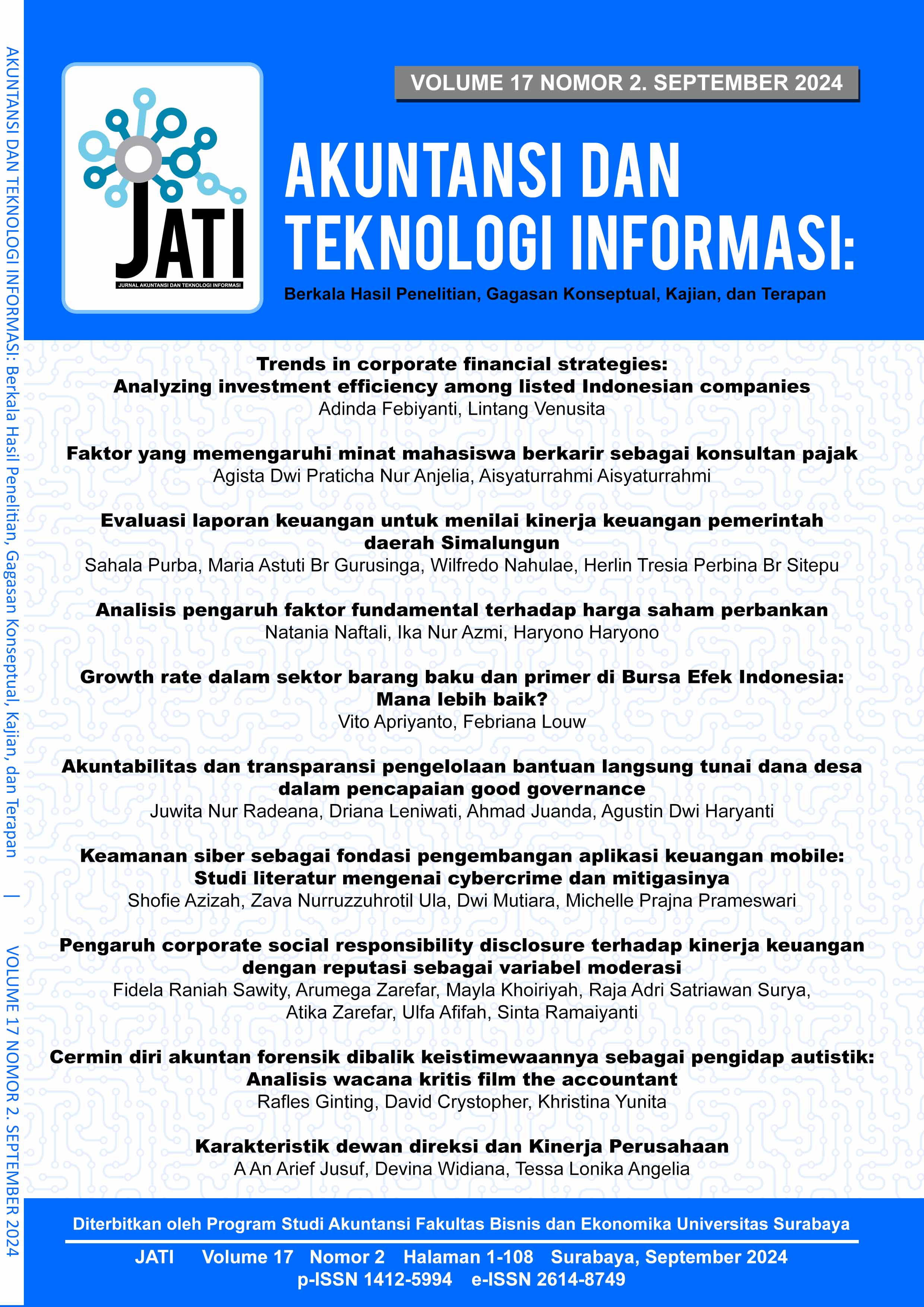Karakteristik dewan direksi dan kinerja perusahaan
 Abstract Views:
409 times
Abstract Views:
409 times
 PDF Downloads:
327 times
PDF Downloads:
327 times
Abstract
The high demand for products from this sector supports the growth in the market capitalization value of companies in the energy sector. The managerial function of the board of directors can be observed through the company’s performance achievements. Based on the upper-echelon theory, perspectives influenced by the personal attributes of top management are used to evaluate situations and potential decisions. This study examines the influence of gender diversity, board size, and CEO tenure on company performance. The results of this study can serve as an additional reference for academics and practitioners. The population characteristics of this study include energy sector companies listed on the main board of the Indonesia Stock Exchange that published annual reports during the period 2012-2022. The data analysis method used is multiple linear regression with panel data, employing the pooled ordinary least squares (OLS) method. The Arellano robust standard errors in pooled panels were used for hypothesis testing interpretation. Gender diversity was found to have no significant effect on company performance. Board size has a positive effect on company performance, while CEO tenure does not significantly affect company performance.
Downloads
References
Adams, R. B., & Ferreira, D. (2009). Women in the Boardroom and Their Impact on Governance and Performance. Journal of Financial Economics, 94(2), 291–309. https://doi.org/https://doi.org/10.1016/j.jfineco.2008.10.007
Agarwal, V., Vashishtha, R., & Venkatachalam, M. (2018). Mutual Fund Transparency and Corporate Myopia. The Review of Financial Studies, 31(5), 1966–2003.
Ahmadi, A., & Bouri, A. (2017). Board of directors’ composition and performance in French CAC 40 listed firms. Accounting, 3, 245–256. https://doi.org/10.5267/j.ac.2017.1.001
An, S. (2022). Board Diversity and Monitoring: An Investigation of Gender and Task-Related Diversity. Public Performance & Management Review, 45(1), 54–79. https://doi.org/10.1080/15309576.2021.1914691
Barber, B. M., & Odean, T. (2001). Boys Will be Boys: Gender, Overconfidence, and Common Stock Investment. The Quarterly Journal of Economics, 116(1), 261–292.
Birken, M.-A., & Cigna, G. P. (2019). Gender Diversity on Boards: In P. Quayle & X. Gao (Eds.), Good Governance and Modern International Financial Institutions (Vol. 1, pp. 25–43). Brill.
Blau, P. M. (1977). Inequality and heterogeneity: A primitive theory of social structure. Free Press, 7.
Bosse, D. A., & Phillips, R. A. (2016). Agency theory and bounded self-interest. The Academy of Management Review, 41(2), 276–297.
Bursa Efek Indonesia. (2023). Daftar Saham Sektor Energy. IDX.
Campbell, K., & Mínguez-Vera, A. (2008). Gender Diversity in the Boardroom and Firm Financial Performance. Journal of Business Ethics, 83(3), 435–451. https://doi.org/10.1007/s10551-007-9630-y
Carter, D. A., Simkins, B. J., & Simpson, W. G. (2003). Corporate Governance, Board Diversity, and Firm Value. Financial Review, 38(1), 33–53. https://doi.org/10.1111/1540-6288.00034
Ciftci, I., Tatoglu, E., Wood, G., Demirbag, M., & Zaim, S. (2019). Corporate governance and firm performance in emerging markets: Evidence from Turkey. International Business Review, 28(1), 90–103. https://doi.org/https://doi.org/10.1016/j.ibusrev.2018.08.004
CNBC. (2023). Dunia Memanas , Sektor Energi Makin Mengganas. CNBC INDONESIA RESEARCH.
Coleman, M., & Wu, M. (2021). Corporate governance mechanisms and corporate performance of firms in Nigeria and Ghana. International Journal of Productivity and Performance Management, 70(8), 2319–2351. https://doi.org/10.1108/IJPPM-01-2020-0020
DesJardine, M., & Shi, W. (2020). CEO Temporal Focus and Behavioral Agency Theory: Evidence from Mergers and Acquisitions. Academy of Management Journal, 64. https://doi.org/10.5465/amj.2018.1470
Eisenhardt, K. M. (1989). Agency Theory: An Assessment and Review. The Academy of Management Review, 14(1), 57–74. https://doi.org/10.2307/258191
Faccio, M., Marchica, M.-T., & Mura, R. (2016). CEO gender, corporate risk-taking, and the efficiency of capital allocation. Journal of Corporate Finance, 39, 193–209. https://doi.org/https://doi.org/10.1016/j.jcorpfin.2016.02.008
Gordon, I. M., Hrazdil, K., Jermias, J., & Li, X. (2021). The Effect of Misalignment of CEO Personality and Corporate Governance Structures on Firm Performance. In Journal of Risk and Financial Management (Vol. 14, Issue 8). https://doi.org/10.3390/jrfm14080375
Hambrick, D. C., Humphrey, S. E., & Gupta, A. (2015). Structural interdependence within top management teams: A key moderator of upper echelons predictions. Strategic Management Journal, 36(3), 449–461.
Hambrick, D. C., & Mason, P. A. (1984). Upper Echelons: The Organization as a Reflection of Its Top Managers. The Academy of Management Review, 9(2), 193–206. https://doi.org/10.2307/258434
Hemza, B. (2020). Board of directors’ size and firm performance: Evidence from non-financial French firms listed on CAC 40. Studies in Business & Economics, 15(2), 46–61. https://doi.org/10.2478/sbe-2020-0024
Henderson, A. D., Miller, D., & Hambrick, D. C. (2006). How Quickly Do CEOs Become Obsolete? Industry Dynamism, CEO Tenure, and Company Performance. Strategic Management Journal, 27(5), 447–460.
Huang, J., & Kisgen, D. J. (2013). Gender and corporate finance: Are male executives overconfident relative to female executives? Journal of Financial Economics, 108(3), 822–839. https://doi.org/https://doi.org/10.1016/j.jfineco.2012.12.005
Jensen, M. C. (1993). The Modern Industrial Revolution, Exit, and the Failure of Internal Control Systems. The Journal of Finance, 48(3), 831–880. https://doi.org/10.2307/2329018
Kamal Hassan, M., & Saadi Halbouni, S. (2013). Corporate governance, economic turbulence and financial performance of UAE listed firms. Studies in Economics and Finance, 30(2), 118–138. https://doi.org/10.1108/10867371311325435
Kaur, R., & Singh, B. (2019). Do CEO characteristics explain firm performance in India? TT - Firm performance in India. Journal of Strategy and Management, 12(3), 409–426. https://doi.org/https://doi.org/10.1108/JSMA-02-2019-0027
Khan, A., Tanveer, S., & Malik, U. (2017). An empirical analysis of corporate governance and firm value: Evidence from KSE-100 Index. Accounting, 3(2), 119–130. https://doi.org/10.5267/j.ac.2016.7.003
Koryak, O., Lockett, A., Hayton, J., Nicolaou, N., & Mole, K. (2018). Disentangling the antecedents of ambidexterity: Exploration and exploitation. Research Policy, 47(2), 413–427. https://doi.org/https://doi.org/10.1016/j.respol.2017.12.003
LCDI. (2023). Energi. https://lcdi-indonesia.id/grk-energi/
Levi, M., Li, K., & Zhang, F. (2014). Director gender and mergers and acquisitions. Journal of Corporate Finance, 28, 185–200. https://doi.org/https://doi.org/10.1016/j.jcorpfin.2013.11.005
Liao, L., Lin, T. (Philip), & Zhang, Y. (2018). Corporate Board and Corporate Social Responsibility Assurance: Evidence from China. Journal of Business Ethics, 150(1), 211–225. https://doi.org/10.1007/s10551-016-3176-9
Low, D. C. M., Roberts, H., & Whiting, R. H. (2015). Board Gender Diversity and Firm Performance: Empirical Evidence from Hong Kong, South Korea, Malaysia and Singapore. Pacific-Basin Finance Journal, 35, 381–401. https://doi.org/https://doi.org/10.1016/j.pacfin.2015.02.008
Mashayekhi, B., & Bazaz, M. S. (2008). Corporate Governance and Firm Performance in Iran. Journal of Contemporary Accounting & Economics, 4(2), 156–172. https://doi.org/https://doi.org/10.1016/S1815-5669(10)70033-3
Mastella, M., Vancin, D., Perlin, M., & Kirch, G. (2021). Board gender diversity: performance and risk of Brazilian firms. Gender in Management: An International Journal, 36(4), 498–518. https://doi.org/10.1108/GM-06-2019-0088
Merendino, A., & Melville, R. (2019). The board of directors and firm performance: empirical evidence from listed companies. Corporate Governance: The International Journal of Business in Society, 19(3), 508–551. https://doi.org/10.1108/CG-06-2018-0211
Perryman, A. A., Fernando, G. D., & Tripathy, A. (2016). Do gender differences persist? An examination of gender diversity on firm performance, risk, and executive compensation. Journal of Business Research, 69(2), 579–586. https://doi.org/https://doi.org/10.1016/j.jbusres.2015.05.013
Rodrigues, C. G., & Sousa, B. B. (2024). The role of employer branding and internal marketing in talent attraction and retention: an applied study in a Portuguese metallurgical industry. EuroMed Journal of Business, ahead-of-p(ahead-of-print). https://doi.org/10.1108/EMJB-07-2023-0173
Shen, W. (2003). The dynamics of the CEO-board relationship: An evolutionary perspective. Academy of Management Review, 28(3), 466–476. https://doi.org/10.5465/AMR.2003.10196776
Shen, Y. (2021). CEO characteristics: a review of influential publications and a research agenda. Accounting & Finance, 61(1), 361–385. https://doi.org/10.1111/acfi.12571
Shen, Y., Wallace, D., Reddy, K., & Ramiah, V. (2022). An investigation of CEO characteristics on firm performance. Accounting & Finance, 62(3), 3563–3607. https://doi.org/10.1111/acfi.12896
Sood, K., Pathak, P., & Gupta, S. (2024). How do the determinants of investment decisions get prioritized? Peeking into the minds of investors. Kybernetes, ahead-of-p(ahead-of-print). https://doi.org/10.1108/K-04-2023-0662
Tampakoudis, I., Nerantzidis, M., Artikis, P., & Kiosses, N. (2022). The effect of board size on shareholder value: Evidence from bank mergers and acquisitions. European Management Journal, 40(6), 883–894. https://doi.org/https://doi.org/10.1016/j.emj.2022.09.002
Villanueva-Villar, M., Rivo-López, E., & Lago-Peñas, S. (2016). On the relationship between corporate governance and value creation in an economic crisis: Empirical evidence for the Spanish case. BRQ Business Research Quarterly, 19(4), 233–245. https://doi.org/https://doi.org/10.1016/j.brq.2016.06.002

This work is licensed under a Creative Commons Attribution-ShareAlike 4.0 International License.
- Copyright on articles is retained by the respective author(s), without restrictions. A non-exclusive license is granted to Akuntansi dan Teknologi Informasi (JATI) to publish the article and identify itself as its original publisher, along with the commercial right to include the article in a hardcopy issue for sale to libraries and individuals.
- Articles published in Akuntansi dan Teknologi Informasi (JATI) are licensed under a Creative Commons Attribution-ShareAlike 4.0 International license. You are free to copy, transform, or redistribute articles for any lawful purpose in any medium, provided you give appropriate credit to the original author(s) and the journal, link to the license, indicate if changes were made, and redistribute any derivative work under the same license.
- By publishing in Akuntansi dan Teknologi Informasi (JATI), authors grant any third party the right to use their article to the extent provided by the Creative Commons Attribution-ShareAlike 4.0 International license.

 DOI:
DOI:









